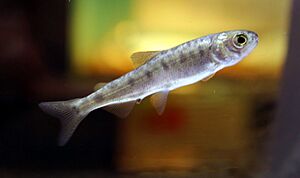Oncorhynchus kawamurae facts for kids
Quick facts for kids Oncorhynchus kawamurae |
|
|---|---|
 |
|
| A young kunimasu at the Fuji Yusui no Sato Aquarium | |
| Conservation status | |
| Scientific classification |
The Black kokanee (Oncorhynchus kawamurae), also known as kunimasu (国鱒) in Japanese, is a special type of trout found only in freshwater lakes in Japan. For 70 years, people thought this fish was completely gone from the world. But in 2010, it was amazingly found again!
This fish used to live only in Lake Tazawa in Akita Prefecture. However, before it disappeared, some of its eggs were moved to Lake Saiko. This was an attempt to save the species. Nobody knew if this plan worked until 2010. That's when a group of scientists, including a famous biologist named 'Sakana-kun', found nine of these fish in Lake Saiko.
The Black kokanee is related to the sockeye salmon. It has a dark olive color with black spots on its back. It can grow to be about 1 foot (30 centimeters) long. Its body is long, slim, and flat. However, its color and shape can change a bit depending on if it's a male or female, and how old it is.
Contents
A Fish Thought to Be Extinct
The Kunimasu fish originally lived only in Lake Tazawa in Japan. In 1935, some of its fertilized eggs were moved to other lakes in Japan. One of these lakes was Lake Saiko in Yamanashi Prefecture. People thought this effort to move them had failed.
Then, in 1940, something sad happened. Water from the Tama River was added to Lake Tazawa. This was done to help make more electricity from a local dam. But the new water was very acidic. Salmon, like the Kunimasu, are very sensitive to changes in water quality. The acidic water killed all the Kunimasu in Lake Tazawa. For the next 70 years, everyone believed the Kunimasu was extinct.
But in 2010, nine of these fish were found alive in Lake Saiko! Scientists believe these fish are descendants of the eggs that were moved there in the 1930s. It was a huge and exciting discovery!
How Scientists Knew It Was the Kunimasu
The Kunimasu is very similar to another type of land-locked sockeye salmon called Himemasu. Himemasu had also been put into Lake Saiko many times. Because they looked so much alike, scientists wondered if the newly found fish were truly Kunimasu. They also wondered if they might be a mix of the two species.
However, scientists found that the two species do not reproduce with each other. This meant the fish found in 2010 were indeed the surviving Kunimasu. They looked at things like the Kunimasu's special breeding season. They also counted tiny parts inside the fish, like its gill-rakers. Later, they used DNA sequencing to confirm their findings. This is like checking the fish's unique genetic code.
Where and How They Live
Feeding and Habitat
We don't know a lot about how Kunimasu behave or live. This is because not many studies were done before they were rediscovered in 2010. Scientists think Kunimasu eat tiny water creatures called zooplankton. These are similar to what Himemasu eat in the same area.
This idea is supported by the number of gill rakers the Kunimasu have. It also matches where they like to live. Kunimasu prefer cold, deep lake water. They are found only in freshwater lakes. They live near the bottom of the lake. While they used to live in Lake Tazawa, they are now found only in Lake Saiko. Lake Saiko is about 310 miles (500 kilometers) south of Lake Tazawa.
Morphology and Life Cycle
Kunimasu have black spots and are olive to dark grey. But when they are ready to lay eggs, they turn a dark olive green. To protect their gills, Kunimasu can have up to 43 gill rakers. They also have up to 59 pyloric caeca, which help with digestion. Adult Kunimasu grow to about 30 centimeters (1 foot) long.
As Kunimasu grow, their bodies change. This includes changes in color and size. When they are mature, both male and female Kunimasu have long, slim, and flat bodies. Males usually have a slightly longer, pointed snout. Females have a shorter snout.
During the spawning season, when they lay eggs, their bodies change even more. Males and females can develop a hump on their back. Their snouts might also change shape. Female Kunimasu also have a larger mouth during this time.
Spawning happens in winter and spring, about 30 to 40 meters deep in the lake. Females prepare their spawning beds by wiggling their bodies. This can sometimes damage their tail fins.
Images for kids



